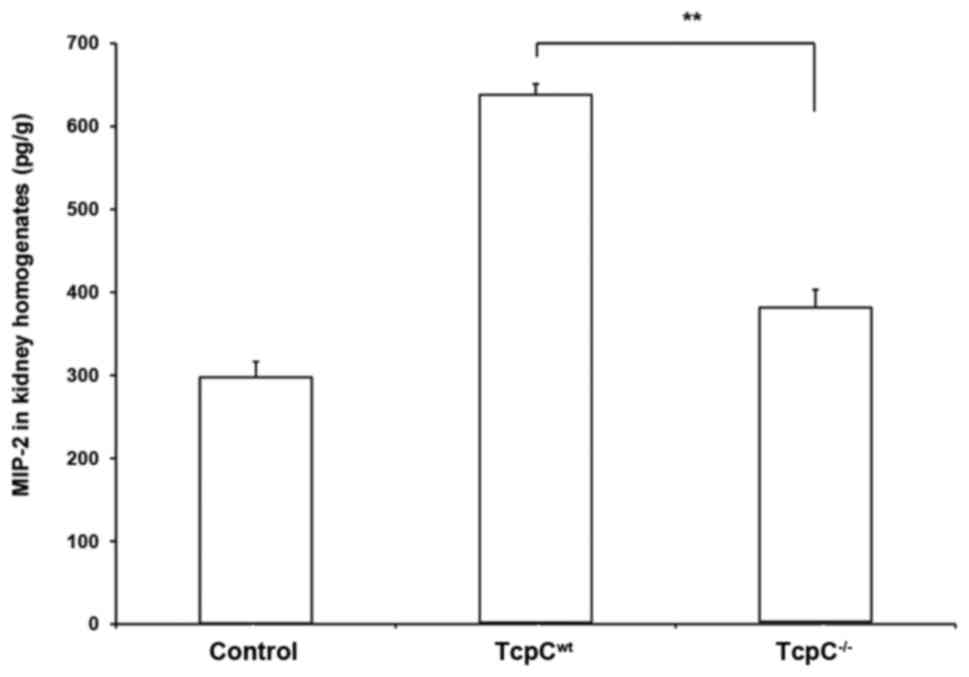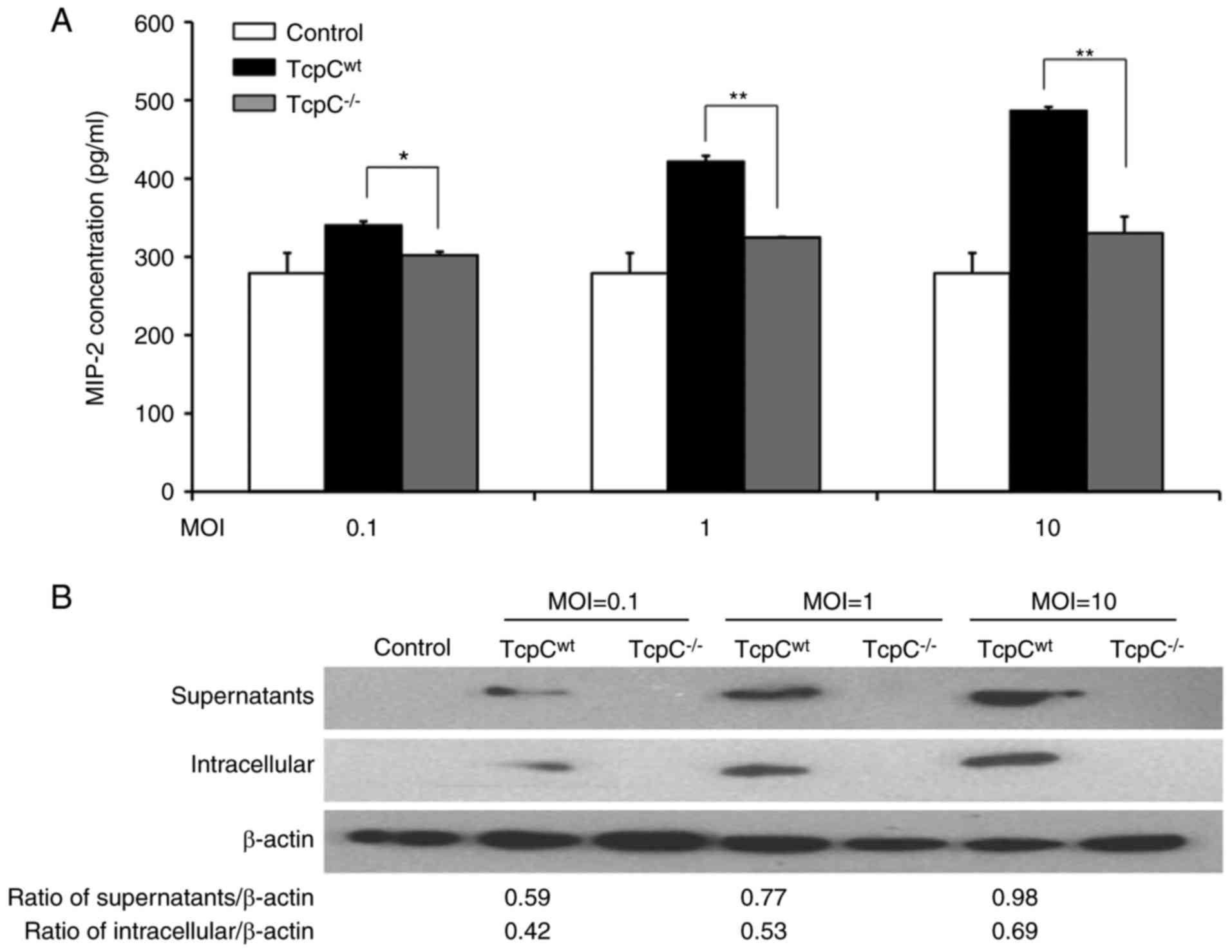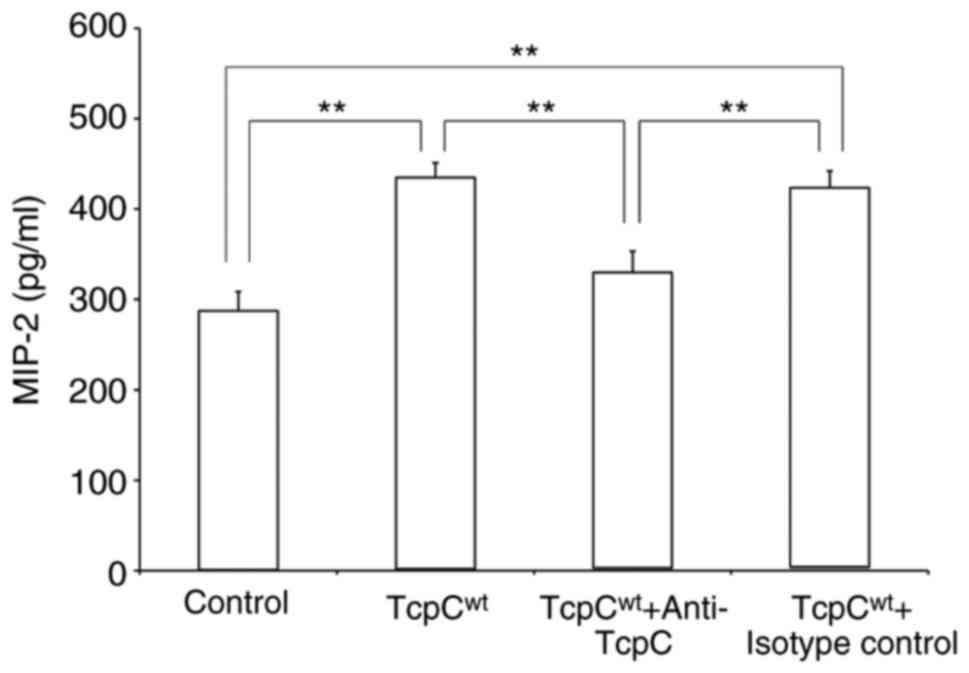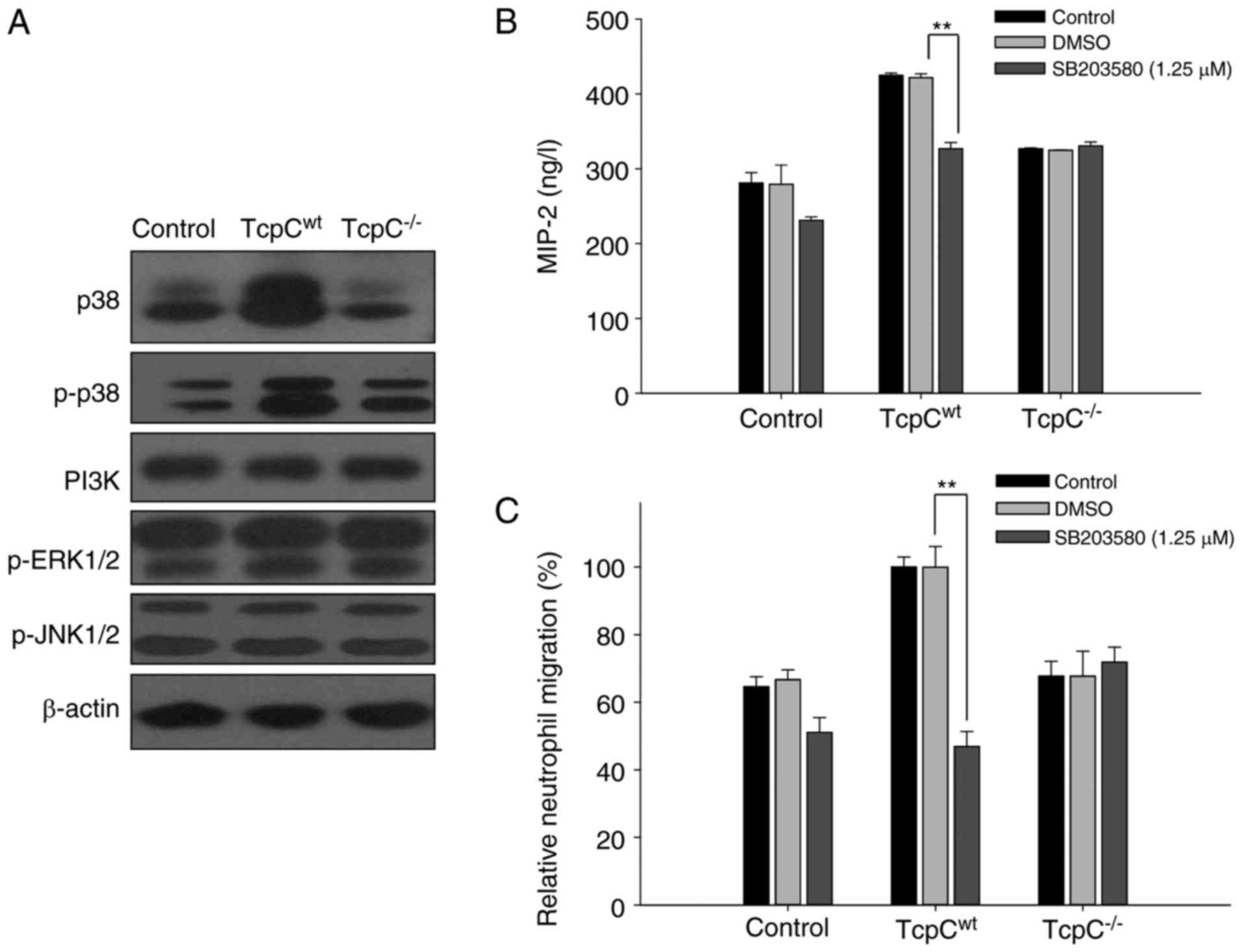|
1
|
Pinson AG, Philbrick JT, Lindbeck GH and
Schorling JB: Oral antibiotic therapy for acute pyelonephritis: A
methodologic review of the literature. J Gen Intern Med. 7:544–553.
1992. View Article : Google Scholar : PubMed/NCBI
|
|
2
|
Tambo M, Okegawa T, Shishido T,
Higashihara E and Nutahara K: Predictors of septic shock in
obstructive acute pyelonephritis. World J Urol. 32:803–811. 2014.
View Article : Google Scholar : PubMed/NCBI
|
|
3
|
Foxman B: Epidemiology of urinary tract
infections: Incidence, morbidity, and economic costs. Dis Mon.
49:53–70. 2003. View Article : Google Scholar : PubMed/NCBI
|
|
4
|
Haraoka M, Hang L, Frendéus B, Godaly G,
Burdick M, Strieter R and Svanborg C: Neutrophil recruitment and
resistance to urinary tract infection. J Infect Dis. 180:1220–1229.
1999. View
Article : Google Scholar : PubMed/NCBI
|
|
5
|
Bhansali RS, Yeltiwar RK and Bhat KG:
Assessment of peripheral neutrophil functions in patients with
localized aggressive periodontitis in the Indian population. J
Indian Soc Periodontol. 17:731–736. 2013. View Article : Google Scholar : PubMed/NCBI
|
|
6
|
Hang L, Frendeus B, Godaly G and Svanborg
C: Interleukin-8 receptor knockout mice have subepithelial
neutrophil entrapment and renal scarring following acute
pyelonephritis. J Infect Dis. 182:1738–1748. 2000. View Article : Google Scholar : PubMed/NCBI
|
|
7
|
Montecucco F, Lenglet S, Braunersreuther
V, Godaly G, Burdick M, Strieter R and Svanborg C: Single
administration of the CXC chemokine-binding protein Evasin-3 during
ischemia prevents myocardial reperfusion injury in mice.
Arterioscler Thromb Vasc Biol. 30:1371–1377. 2010. View Article : Google Scholar : PubMed/NCBI
|
|
8
|
Driscoll KE, Hassenbein DG, Howard BW,
Isfort RJ, Cody D, Tindal MH, Suchanek M and Carter JM: Cloning,
expression, and functional characterization of rat MIP-2: A
neutrophil chemoattractant and epithelial cell mitogen. J Leukoc
Biol. 58:359–364. 1995.PubMed/NCBI
|
|
9
|
Driscoll KE: TNFalpha and MIP-2: Role in
particle-induced inflammation and regulation by oxidative stress.
Toxicol Lett. 112–113:177–183. 2000. View Article : Google Scholar
|
|
10
|
Tittel AP, Heuser C, Ohliger C, Knolle PA,
Engel DR and Kurts C: Kidney dendritic cells induce innate immunity
against bacterial pyelonephritis. J Am Soc Nephrol. 22:1435–1441.
2011. View Article : Google Scholar : PubMed/NCBI
|
|
11
|
Huang YY, Xia MZ, Wang H, Liu XJ, Hu YF,
Chen YH, Zhang C and Xu DX: Cadmium selectively induces MIP-2 and
COX-2 through PTEN-mediated Akt activation in RAW264.7 cells.
Toxicol Sci. 138:310–321. 2014. View Article : Google Scholar : PubMed/NCBI
|
|
12
|
Tateno N, Matsumoto N, Motowaki T, Suzuki
K and Aratani Y: Myeloperoxidase deficiency induces MIP-2
production via ERK activation in zymosan-stimulated mouse
neutrophils. Free Radic Res. 47:376–385. 2013. View Article : Google Scholar : PubMed/NCBI
|
|
13
|
Janssens S and Beyaert R: Functional
diversity and regulation of different interleukin-1
receptor-associated kinase (IRAK) family members. Mol Cell.
11:293–302. 2003. View Article : Google Scholar : PubMed/NCBI
|
|
14
|
Marumo S, Hoshino Y, Kiyokawa H, Tanabe N,
Sato A, Ogawa E, Muro S, Hirai T and Mishima M: p38
mitogen-activated protein kinase determines the susceptibility to
cigarette smoke-induced emphysema in mice. BMC Pulm Med. 14:792014.
View Article : Google Scholar : PubMed/NCBI
|
|
15
|
Schnyder-Candrian S, Quesniaux VF, Di
Padova F, Maillet I, Noulin N, Couillin I, Moser R, Erard F,
Vargaftig BB, Ryffel B and Schnyder B: Dual effects of p38 MAPK on
TNF-dependent bronchoconstriction and TNF-independent neutrophil
recruitment in lipopolysaccharide-induced acute respiratory
distress syndrome. J Immunol. 175:262–269. 2005. View Article : Google Scholar : PubMed/NCBI
|
|
16
|
Tarchouna M, Ferjani A, Ben-Selma W and
Boukadida J: Distribution of uropathogenic virulence genes in
Escherichia coli isolated from patients with urinary tract
infection. Int J Infect Dis. 17:e450–e453. 2013. View Article : Google Scholar : PubMed/NCBI
|
|
17
|
Blum-Oehler G, Dobrindt U, Janke B, Nagy
G, Piechaczek K and Hacker J: Pathogenicity islands of
uropathogenic E. coli and evolution of virulence. Adv Exp
Med Biol. 485:25–32. 2000. View Article : Google Scholar : PubMed/NCBI
|
|
18
|
Derakhshandeh A, Firouzi R, Motamedifar M,
Boroojeni A Motamedi, Bahadori M, Arabshahi S, Novinrooz A and
Heidari S: Distribution of virulence genes and multiple
drug-resistant patterns amongst different phylogenetic groups of
uropathogenic Escherichia coli isolated from patients with
urinary tract infection. Lett Appl Microbiol. 60:148–154. 2015.
View Article : Google Scholar : PubMed/NCBI
|
|
19
|
Cirl C, Wieser A, Yadav M, Duerr S,
Schubert S, Fischer H, Stappert D, Wantia N, Rodriguez N, Wagner H,
et al: Subversion of Toll-like receptor signaling by a unique
family of bacterial Toll/interleukin-1 receptor domain-containing
proteins. Nat Med. 14:399–406. 2008. View
Article : Google Scholar : PubMed/NCBI
|
|
20
|
Snyder GA, Cirl C, Jiang J, Chen K,
Waldhuber A, Smith P, Römmler F, Snyder N, Fresquez T, Dürr S, et
al: Molecular mechanisms for the subversion of MyD88 signaling by
TcpC from virulent uropathogenic Escherichia coli. Proc Natl
Acad Sci USA. 110:6985–6990. 2013. View Article : Google Scholar : PubMed/NCBI
|
|
21
|
Yadav M, Zhang J, Fischer H, Huang W,
Lutay N, Cirl C, Lum J, Miethke T and Svanborg C: Inhibition of TIR
domain signaling by TcpC: MyD88-dependent and independent effects
on Escherichia coli virulence. PLoS Pathog. 6:e10011202010.
View Article : Google Scholar : PubMed/NCBI
|
|
22
|
Waldhuber A, Puthia M, Wieser A, Cirl C,
Dürr S, Neumann-Pfeifer S, Albrecht S, Römmler F, Müller T, Zheng
Y, et al: Uropathogenic Escherichia coli strain CFT073
disrupts NLRP3 inflammasome activation. J Clin Invest.
126:2425–2436. 2016. View Article : Google Scholar : PubMed/NCBI
|
|
23
|
Zhang C, Zhou JL, Fang J, Zhang DY, Wang
BM, Chen RL and Pan JP: TcpC induces apoptosis of human vascular
endothelial cells and its mechanisms. Zhejiang Da Xue Xue Bao Yi
Xue Ban. 42:492–497. 2013.(In Chinese). PubMed/NCBI
|
|
24
|
Zhang DY, Lin YQ, He F, Fang J, Zhang C,
Wang BM and Pan JP: TcpC induces apoptosis of macrophages through
promoting ROS production. Zhejiang Da Xue Xue Bao Yi Xue Ban.
42:486–491. 2013.(In Chinese). PubMed/NCBI
|
|
25
|
Cox G: Glucocorticoid treatment inhibits
apoptosis in human neutrophils. Separation of survival and
activation outcomes. J Immunol. 154:4719–4725. 1995.PubMed/NCBI
|
|
26
|
Ragnarsdóttir B and Svanborg C:
Susceptibility to acute pyelonephritis or asymptomatic bacteriuria:
Host-pathogen interaction in urinary tract infections. Pediatr
Nephrol. 27:2017–2029. 2012. View Article : Google Scholar : PubMed/NCBI
|
|
27
|
Gupta K, Hooton TM, Naber KG, Wullt B,
Colgan R, Miller LG, Moran GJ, Nicolle LE, Raz R, Schaeffer AJ, et
al: International clinical practice guidelines for the treatment of
acute uncomplicated cystitis and pyelonephritis in women: A 2010
update by the infectious diseases society of America and the
European society for microbiology and infectious diseases. Clin
Infect Dis. 52:e103–e120. 2011. View Article : Google Scholar : PubMed/NCBI
|
|
28
|
Smith JA: Neutrophils, host defense, and
inflammation: A double-edged sword. J Leukoc Biol. 56:672–686.
1994.PubMed/NCBI
|
|
29
|
Segal AW: How neutrophils kill microbes.
Annu Rev Immunol. 23:197–223. 2005. View Article : Google Scholar : PubMed/NCBI
|
|
30
|
Svensson M, Irjala H, Svanborg C and
Godaly G: Effects of epithelial and neutrophil CXCR2 on innate
immunity and resistance to kidney infection. Kidney Int. 74:81–90.
2008. View Article : Google Scholar : PubMed/NCBI
|
|
31
|
Ng LG, Qin JS, Roediger B, Wang Y, Jain R,
Cavanagh LL, Smith AL, Jones CA, de Veer M, Grimbaldeston MA, et
al: Visualizing the neutrophil response to sterile tissue injury in
mouse dermis reveals a three-phase cascade of events. J Invest
Dermatol. 131:2058–2068. 2011. View Article : Google Scholar : PubMed/NCBI
|
|
32
|
Sadik CD, Kim ND and Luster AD:
Neutrophils cascading their way to inflammation. Trends Immunol.
32:452–460. 2011. View Article : Google Scholar : PubMed/NCBI
|
|
33
|
Shanley TP, Schmal H, Warner RL, Schmid E,
Friedl HP and Ward PA: Requirement for C-X-C chemokines (macrophage
inflammatory protein-2 and cytokine-induced neutrophil
chemoattractant) in IgG immune complex-induced lung injury. J
Immunol. 158:3439–3448. 1997.PubMed/NCBI
|
|
34
|
Aratani Y, Miura N, Ohno N and Suzuki K:
Role of neutrophil-derived reactive oxygen species in host defense
and inflammation. Med Mycol J. 53:123–128. 2012.(In Japanese).
View Article : Google Scholar : PubMed/NCBI
|
|
35
|
Armstrong DA, Major JA, Chudyk A and
Hamilton TA: Neutrophil chemoattractant genes KC and MIP-2 are
expressed in different cell populations at sites of surgical
injury. J Leukoc Biol. 75:641–648. 2004. View Article : Google Scholar : PubMed/NCBI
|
|
36
|
Hang L, Haraoka M, Agace WW, Leffler H,
Burdick M, Strieter R and Svanborg C: Macrophage inflammatory
protein-2 is required for neutrophil passage across the epithelial
barrier of the infected urinary tract. J Immunol. 162:3037–3044.
1999.PubMed/NCBI
|
|
37
|
Kurosaka K, Takahashi M and Kobayashi Y:
Activation of extracellular signal-regulated kinase 1/2 is involved
in production of CXC-chemokine by macrophages during phagocytosis
of late apoptotic cells. Biochem Biophys Res Commun. 306:1070–1074.
2003. View Article : Google Scholar : PubMed/NCBI
|
|
38
|
Kawaguchi M, Onuchic LF and Huang SK:
Activation of extracellular signal-regulated kinase (ERK)1/2, but
not p38 and c-Jun N-terminal kinase, is involved in signaling of a
novel cytokine, ML-1. J Biol Chem. 277:15229–15232. 2002.
View Article : Google Scholar : PubMed/NCBI
|
|
39
|
Heit B, Liu L, Colarusso P, Puri KD and
Kubes P: PI3K accelerates, but is not required for, neutrophil
chemotaxis to fMLP. J Cell Sci. 121:205–214. 2008. View Article : Google Scholar : PubMed/NCBI
|
|
40
|
Zampetaki A, Mitsialis SA, Pfeilschifter J
and Kourembanas S: Hypoxia induces macrophage inflammatory
protein-2 (MIP-2) gene expression in murine macrophages via
NF-kappaB: The prominent role of p42/p44 and PI3 kinase pathways.
FASEB J. 18:1090–1092. 2004.PubMed/NCBI
|














